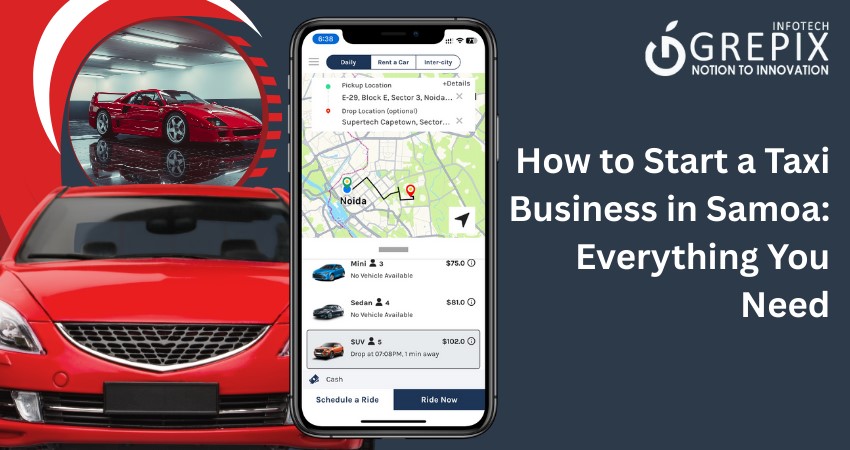How to Start a Taxi Business in Samoa: Everything You Need
Starting a taxi business in Samoa can be a rewarding opportunity, given the demand for reliable transportation. To succeed, you'll need to register your business, obtain the necessary permits, invest in quality vehicles, and follow local regulations. With proper planning and good customer service, you can build a profitable and trusted taxi service.
Starting a taxi business in Samoa can be a profitable venture, given the country's growing tourism industry and local transportation needs. However, it requires careful planning, compliance with regulations, and strategic investment. Here’s everything you need to know to get started.
Starting a taxi business in Samoa is a smart move in 2025, with high tourist footfall and an underserved transport market. To succeed, entrepreneurs must follow a clear roadmap—from market research and fleet procurement to licensing and digital marketing. The real game-changer, however, is technology. Grepix Infotech offers a powerful, customizable taxi app platform that enables quick, efficient, and profitable taxi business launches. Their solution includes rider and driver apps, an admin dashboard, local payment support, and essential safety features. With live demos, global success stories, and affordable pricing, Grepix is an ideal partner for any taxi startup in Samoa. By focusing on branding, customer service, and strategic scaling, entrepreneurs can build a long-lasting, trusted transportation brand across the islands.
1 Introduction
Starting a taxi business in Samoa in 2025 is more promising than ever before. With the rise in tourism, the need for efficient local transportation, and a growing population demanding digital services, the time is ripe for entrepreneurs to launch a modern, app-driven taxi service. Traditional taxi systems are fading, and what’s replacing them is smart, GPS-enabled, mobile-based ride-hailing platforms.
Why Samoa? This Pacific island nation, while smaller in population, sees thousands of tourists yearly, especially in Apia and the coastal regions. Locals also face the daily challenge of inconsistent public transport. Entrepreneurs can fill this gap with a reliable, well-branded taxi business that runs on technology fast, safe, and customer-centric.
Grepix Infotech, a leading taxi app software provider, has helped hundreds of startups go live in record time. With their tailored taxi solutions, you won’t just launch a taxi company; you’ll launch a tech-first mobility brand. In this article, we’ll take you through a complete roadmap to start a taxi business in Samoa, and how Grepix can be your best partner on this journey.
2 Understanding the Taxi Business Landscape in Samoa
Samoa is experiencing a slow but steady digital transformation. As a result, there's a widening gap between the demand for quality transportation and the services available. Currently, most taxis operate informally, without digital bookings or customer engagement platforms. This creates an opportunity for structured, app-based taxi businesses to thrive.
Economic & Tourism Boost
Tourism is one of Samoa’s key economic drivers. Hotels, resorts, and cruise ports in Apia and other popular destinations see constant foot traffic. A well-structured taxi app that offers scheduled pickups, real-time tracking, and fixed pricing can cater perfectly to tourists and locals alike.
Regulatory Framework
Setting up a business in Samoa is relatively straightforward. However, like anywhere else, starting a taxi business requires compliance. You’ll need a taxi permit, roadworthiness certificates for your vehicles, and driver vetting. This is manageable, and Grepix can even guide you through these requirements with its startup consultations.
Local Transport Needs
Most Samoans still rely on buses and unregistered taxis. A mobile app-based taxi service provides safety, consistency, and convenience—especially for young professionals and tourists. The market is ripe for disruption, and with the right strategy, you can build a brand that becomes synonymous with trusted transport.
3 Step-by-Step Process to Start a Taxi Business in Samoa
Market Research and Planning
Before diving in, understand who your customers are. Are you targeting tourists, locals, or both? What times of the day is demand highest? Which areas need more service coverage? Use online surveys, interviews, or social media insights to answer these.
Create a detailed business plan. Include competitor analysis, startup costs, revenue projections, and break-even estimates. Focus on how your tech-based solution will stand out.
Business Registration and Licensing
Register your business with the Samoa Ministry of Commerce, Industry and Labour. You’ll need:
- Business license
- Taxpayer Identification Number (TIN)
- Taxi vehicle permits
- Driver licenses with background checks
Depending on your business model (private hire vs. open taxi), the permit structure might differ.
Fleet Procurement and Driver Recruitment
Decide whether you'll buy vehicles or onboard independent drivers (like Uber). Ensure your fleet is fuel-efficient, roadworthy, and comfortable. Vehicle branding adds visibility.
For recruitment, use background-checked drivers with clean driving records. Grepix’s app includes driver onboarding modules that automate registration, document upload, and training.
Insurance and Safety Compliance
Get vehicle insurance that covers accidents, third-party liability, and passenger protection. Safety compliance also means regular vehicle servicing and GPS tracking—features Grepix’s solution already supports.
Branding and Marketing Your Taxi Business
Your brand isn’t just your name or logo. It’s the experience you promise. Choose a name that resonates locally, build a mobile-friendly website, and design eye-catching car decals. Grepix helps brand your app with a logo, theme colors, and a domain that aligns with your business identity.
Marketing should begin before the launch. Tease your arrival on social media, offer launch promos, and partner with hotels and local influencers to drive installs.
4 Role of Technology in the Modern Taxi Industry
Gone are the days when hailing a cab was all about waving your hand. In the current digital landscape, people expect more reliable booking, real-time tracking, secure payments, and immediate feedback.
Grepix offers a comprehensive taxi app solution that includes:
- Customer app (iOS & Android)
- Driver app (iOS & Android)
- Admin panel for business owners
- Dispatcher panel for fleet management
These tools help you manage rides, payments, ratings, vehicle tracking, and even marketing all from one dashboard.
Additionally, tech enables cashless payments via cards, wallets, or mobile money, which is quickly becoming the norm across the Pacific.
Grepix’s solution is also built with safety in mind: emergency SOS features, driver ratings, in-app chat, and GPS-based ride sharing.
5 Why Choose Grepix Infotech for Your Taxi Business
Grepix Infotech isn’t just another software development company—they specialize in taxi app solutions. Their ready-to-launch platform saves time and reduces the learning curve for new entrepreneurs.
Overview of Grepix Infotech
Grepix has helped over 1000+ transportation startups worldwide. Their apps are live in 75+ countries, tailored to local laws, languages, and currencies.
Features of Grepix Taxi App Software
- Real-time GPS tracking
- Automated fare calculation
- Driver wallet and payout management
- Referral and promo systems
- Trip history and analytics
Customization and Localization for Samoa
They don’t just clone apps—they personalize them. Grepix will adapt the app for Samoan currency (WST), local language (Samoan/English), cultural expectations, and geographic mapping.
Support and Maintenance Services
Post-launch support is critical. Grepix offers 3-6 months of free maintenance, including bug fixing, server setup, app updates, and scaling help.
Pricing and ROI Potential
Compared to building a custom app from scratch, Grepix’s pricing is very competitive. You can launch in weeks, not months. Their solution ensures fast ROI by cutting development time and avoiding costly errors.
6 Grepix’s Taxi App Demo and Use Cases
Before committing to any tech solution, seeing it in action matters. Grepix Infotech offers live demos of its taxi app software, showcasing the fluid user interface, intuitive user journey, and robust backend. Whether you’re tech-savvy or a first-time entrepreneur, their demos help you understand how your app will function in the real world.
Passenger App Experience
Users can book a ride in seconds, track their driver live, and make payments seamlessly. With intuitive map integrations and fare estimates upfront, passengers feel in control. Grepix’s UI design also ensures accessibility, so even first-time smartphone users in Samoa can use the app with ease.
Driver App Interface
Drivers get turn-by-turn navigation, in-app support, earning dashboards, and ride request management tools. This boosts their confidence and professionalism. For Samoa, where many drivers are semi-independent, this platform provides all-in-one tools to manage their small business on the go.
Admin and Dispatcher Dashboard
As the business owner, you get a powerful dashboard to manage your entire fleet, monitor real-time rides, handle disputes, track revenue, and set promotional offers. You can also access detailed analytics to fine-tune performance and operations.
Use Cases and Global Success Stories
Grepix’s platform is being used across Africa, Asia, and the Pacific Islands—places with similar infrastructure and market patterns as Samoa. These success stories show that even with minimal prior experience, first-time entrepreneurs can go live quickly and scale rapidly.
7 How Grepix Expedites Taxi Business Launches
Time is money, especially when launching a tech startup. Most custom app developers take 6-9 months just for MVP development. Grepix changes the game by offering a fully customizable, pre-built taxi app system that can be deployed in as little as 7–14 days.
Streamlined Development Process
Their process includes:
- Requirement gathering and consultation
- White-labeling your brand and logo
- Language/currency integration
- Payment gateway setup
- App testing and QA
- Google Play Store & Apple App Store deployment
All this is handled without needing a technical background from your end.
Technical Stack for High Performance
Grepix uses robust technologies such as Node.js, Flutter, and MongoDB to deliver a stable app ecosystem. Whether you’re running 5 cars or scaling to 500+, their platform remains secure and lightning-fast.
Ongoing Assistance Post-Launch
What happens after you launch? Grepix doesn’t vanish. Their ongoing support includes:
- Bug fixes and feature updates
- Server monitoring
- Backup and recovery options
- Feature upgrades based on user feedback
This means you stay competitive and always ahead of the curve.
8 Marketing Strategies for a Taxi Business in Samoa
Even the best taxi app needs users. Marketing is what gets those first 1000 downloads. Here’s how you can promote your new ride-hailing service in Samoa:
Digital Marketing Techniques
- Social Media Ads: Run Facebook and Instagram campaigns targeting Apia and surrounding areas. Focus on tourists and young professionals.
- Google Ads: Rank high on search terms like “book taxi in Samoa” or “airport cab Apia.”
- Local SEO: Create a Google Business Profile and list on Samoan business directories.
Offline & Community Marketing
- Partner with Hotels: Offer exclusive rates for hotel guests and staff.
- Flyers & Stickers: Place them in tourist hotspots, markets, and bus stations.
- Referral Programs: Reward users and drivers for inviting friends.
Promotions That Convert
- First ride free or 50% off
- Loyalty points for repeat rides
- Special event rides for weddings, festivals, or airport transfers
With Grepix’s built-in promo and coupon module, running these campaigns is a breeze.
9 Legal, Tax, and Regulatory Considerations
No business runs on passion alone—legal compliance matters. In Samoa, these are the typical legal requirements for a taxi business:
Business Registration
You’ll register with the Ministry of Commerce, Industry and Labour (MCIL) and obtain:
- Business license
- Company incorporation (optional but advised for liability protection)
- TIN from the Samoa Tax Office
Vehicle and Driver Licensing
Each vehicle used for commercial purposes must:
- Pass annual inspections
- Be registered under the taxi class
- Display taxi identification decals and license
Drivers must:
- Hold a valid driver’s license
- Have no major traffic offenses
- Be medically fit to drive
Insurance and Tax Compliance
Minimum third-party insurance is required, but comprehensive coverage is recommended. For taxes, you’ll file quarterly or annual business returns. Consult with a local accountant to remain compliant with VAT and payroll obligations if hiring employees.
10 Scaling Your Taxi Business in Samoa
Once your app is launched and running smoothly in one city, it’s time to think bigger.
Expanding Fleet and Drivers
Start with 5–10 cars. As demand increases, you can recruit independent drivers or lease vehicles to them. Grepix supports multi-fleet and franchise modules, allowing for easy growth.
Launching in New Areas
After success in Apia, consider launching in other islands or rural hubs. With internet penetration rising, even small towns can benefit from app-based transport.
New Service Verticals
- Airport Rides
- Car Rentals
- Courier and Delivery Services
- Bike Taxis (for short urban routes)
Grepix’s platform allows you to launch these new services under the same app, with toggles for service type.
11 Financial Planning and Revenue Streams
The most exciting part of launching a taxi business is seeing your revenue grow. But before that, proper financial planning is a must. Let’s break it down.
Initial Investment Breakdown
The initial investment for launching a taxi service includes several key expenses. The taxi app software, such as Grepix, costs between WST 4,000 and 8,000. Acquiring vehicles, whether through purchase or leasing, represents a significant portion of the budget, ranging from WST 10,000 to 30,000. Business licensing and permits add another WST 500 to 1,000, while marketing and branding expenses fall between WST 1,000 and 3,000. Additionally, insurance and legal fees range from WST 1,500 to 2,000, ensuring compliance and risk coverage. To safeguard against unforeseen challenges, an emergency fund of WST 2,000 to 3,000 is recommended. In total, the initial investment typically falls between WST 20,000 and 45,000, depending on the fleet size and business scope.
Revenue Streams
Your taxi business can generate income from:
- Ride fares (base fare + distance/time rates)
- Peak pricing surcharges
- In-app advertisements
- Delivery/courier services
- Affiliate partnerships (hotels, events, etc.)
Profitability Tips
- Monitor daily ride volume via the Grepix admin panel
- Optimize driver schedules for peak hours
- Minimize idle time and fuel wastage using GPS analytics
- Use referral programs to grow user base at lower acquisition costs
With good demand, you could reach break-even within 6–9 months.
12 Customer Experience and Service Excellence
Technology will bring you users, but customer experience will keep them coming back. Here's how to make your service unforgettable.
Focus on Safety and Reliability
Ensure every vehicle is well-maintained and cleaned daily. Drivers must wear clean uniforms, behave professionally, and use the app correctly. Grepix has real-time GPS tracking, ride history, and SOS buttons—critical for safety and trust.
Driver Training & Soft Skills
Offer onboarding sessions for drivers to learn:
- How to use the app
- Customer etiquette
- Dealing with complaints
- Time management for pickups and drop-offs
Use Feedback for Growth
Your app includes star ratings, ride reviews, and driver feedback. Take this seriously. Reward top-performing drivers and address complaints quickly.
Create loyalty programs for frequent riders—discounts, referral bonuses, and priority booking can go a long way in building your brand.
Also Read: Accelerating Your Fortune: Becoming a Billionaire in South Africa's Taxi Industry
13 Grepix vs Other Taxi App Providers
There are many taxi app developers out there, but Grepix Infotech stands out for several reasons. Here’s how they compare:
| Feature/Service | Grepix Infotech | Other Providers |
|---|---|---|
| Ready-to-launch platform | ✅ Yes | ❌ Custom dev takes months |
| Custom branding & localization | ✅ Included | ❌ Often extra cost |
| Samoan currency & payment setup | ✅ Fully supported | ❌ Limited regional support |
| Post-launch support | ✅ 3-6 months included | ❌ Extra or limited |
| Pricing | ✅ Mid-range affordable | ❌ High or unclear |
14 Top Challenges Taxi Startups Face in Samoa
Every business has hurdles. But being prepared makes all the difference. Here are the common challenges—and how to overcome them.
Limited Digital Literacy
Not all users are tech-savvy. Some older locals or rural passengers may find apps confusing. Solution? Offer training videos in Samoan, add call booking options, and keep the app interface simple (Grepix helps with this).
Competition from Informal Taxis
Many unlicensed taxis charge low fares. However, they lack safety, app convenience, and consistency. Your value proposition should focus on:
- Safety
- Insurance coverage
- Fixed transparent fares
- Real-time ride tracking
Fuel Prices & Vehicle Maintenance
With fuel being expensive in Samoa, you must monitor vehicle routes and idle times. Grepix’s real-time analytics will help reduce wastage and plan efficient rides.
Conclusion
Launching a taxi business in Samoa represents a promising opportunity in an evolving market where technology plays a pivotal role in driving success. Entrepreneurs today must integrate innovative solutions to meet customer expectations, streamline operations, and stay competitive. Grepix Infotech, as a leading taxi app development company, offers a comprehensive suite of digital tools and expertise that can empower new taxi businesses to thrive. By leveraging cutting-edge technology, robust infrastructure, and user-friendly interfaces, Grepix equips business owners with everything they need to redefine the passenger experience while boosting operational efficiency.
As Samoa’s taxi industry continues to grow, partnering with Grepix Infotech can be the strategic move that paves the way for sustained success and long-term growth in a digitally empowered transportation landscape.Now is your time. Build your brand, empower local drivers, delight your customers and own the roads of Samoa.
FAQs
1. How much does it cost to start a taxi business in Samoa?
Starting costs range from WST 20,000 to 45,000, depending on fleet size, app customization, and marketing.
2. Do I need a permit to operate a taxi in Samoa?
Yes, you need a commercial taxi license, vehicle registration, and business certification from MCIL.
3. Can I operate a taxi business without owning vehicles?
Absolutely. You can onboard independent drivers through the Grepix platform, like Uber.
4. Is the Grepix taxi app customizable for Samoa?
Yes, it supports Samoan currency, local language, and regional mapping.
5. How fast can I launch my taxi app with Grepix?
In most cases, you can go live within 7–14 days with Grepix’s ready-to-launch solution.
Looking out to start your own venture like Uber? Try out our HireMe Taxi Uber Clone, the easiest way to kick-start your taxi business.








